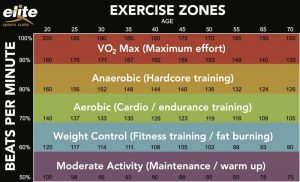
Are you getting the most out of your workouts? Using heart rate zones allows you to measure at what intensity you are exercising, and therefore tailor your workouts for maximum effectiveness. By monitoring how much time you’re spending at each level of intensity, you’ll know how much effort you have to put in to get the results you want.
What are Heart Rate Zones?
A heart rate zone is simply a percentage range of your maximum heart rate. There are typically 5 zones:
- Moderate Activity – 50-60%
- Weight Control – 60-70%
- Aerobic – 70-80%
- Anaerobic – 80-90%
- Red Line – 90-100%
A theoretical maximum heart rate can be measured by your age (See our heart rate monitoring blog for additional details). For a more accurate measurement, you can undergo a VO2 max test with a personal trainer at Elite. Otherwise, heart rate monitors like Myzone can predict what your individual MHR is over time by learning how your body functions. It will use that data to provide more accurate heart rate zone readings in real time.

This chart is a basic guide based on age. It’s not perfectly accurate because every individual is different, but it’s a good benchmark.
Why Are Heart Rate Zones Important?
The effectiveness of your cardiovascular exercise is determined by 3 factors: duration, frequency, and intensity. Duration and frequency are easy to measure, but without some sort of heart rate device, you won’t know exactly what zone you’re in during your workout. Luckily, modern technology has made it much easier to acquire a suitable fitness wearable or heart rate monitor. There are many that come with built-in heart rate monitors and corresponding apps to measure workout intensity.
At Elite Sports Clubs, we recently adopted the Myzone heart rate system. When you wear your belt, you can see in which heart rate zone you’re working in real time, either on your smartphone or on one of the monitors located in the fitness center/group exercise studios.
So why is all of this important? To improve the effectiveness of your workouts. The amount of time you spend in each heart rate zone will show you how much effort you’re putting in. For example, you’ll want to spend more time in the higher zones during a 30-minute workout to get the same results as a 60-minute workout at a moderate level.
You’ll also want to monitor heart rate zones for safety’s sake. You don’t want to overtrain, or spend TOO much time in the higher zones. Overtaining is actually counterproductive. Working too hard can especially be dangerous for those with pre-existing heart conditions.
How Much Time Should I Spend In Each Zone?
The amount of time you spend in each zone really depends on your goals or the type of workout you’re doing. Endurance athletes will typically want to spend more time in the higher zones during training. Weight lifting isn’t as cardio-intensive so you’ll likely spend more time in the lower to middle zones. In most moderate cardio exercises, you’ll find yourself spending the majority of your time in the fat burning zone and higher. Don’t forget to include a warm-up and cool down before and after, respectively.
3 Comments
Have you tested your actual max heart rate? The age formula is very general and people vary a lot. Your max heart rate might be much higher than you think. I’m in my mid 30’s and my max heat rate is over 203 bpm. Its just a genetic thing, doesn’t indicate fitness or lack of fitness.
I’m a male, 66-years-old, in reasonably decent shape. I finish my 3 – 4 days of resistance training a week with 30 minutes doing cardio where I measure 145-155 BPM which, according to the chart, is in my Max Effort zone. I never feel I’m pushing too hard but do get a sweat going. I have no history of of heart disease. What could go wrong?
thank you’
but please let me know specifically how many hours per week